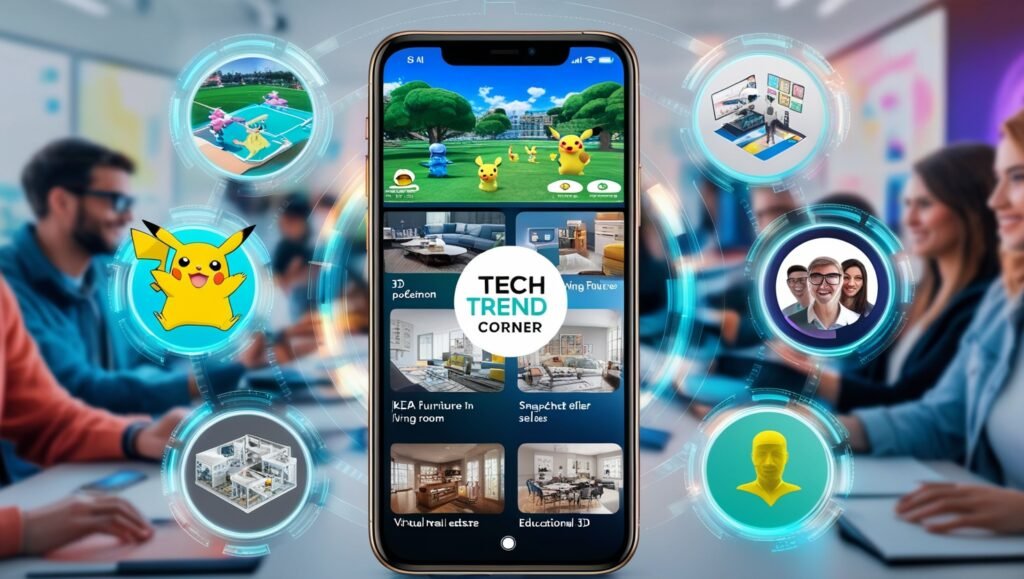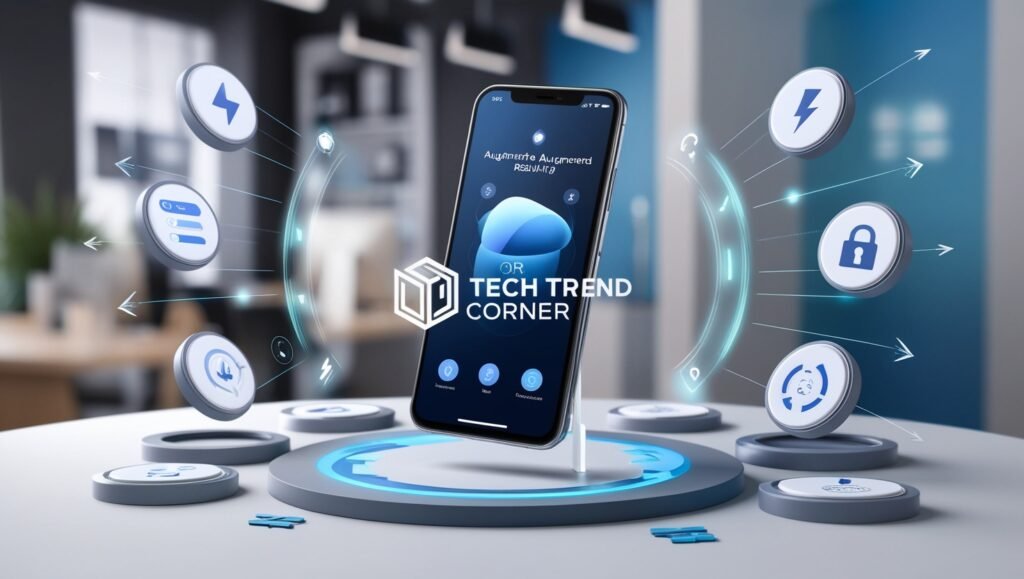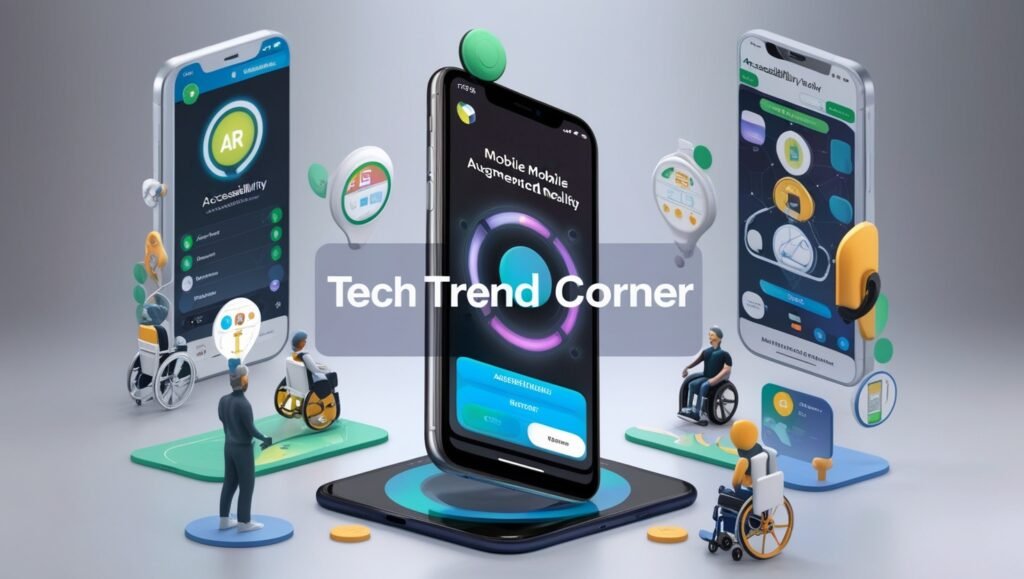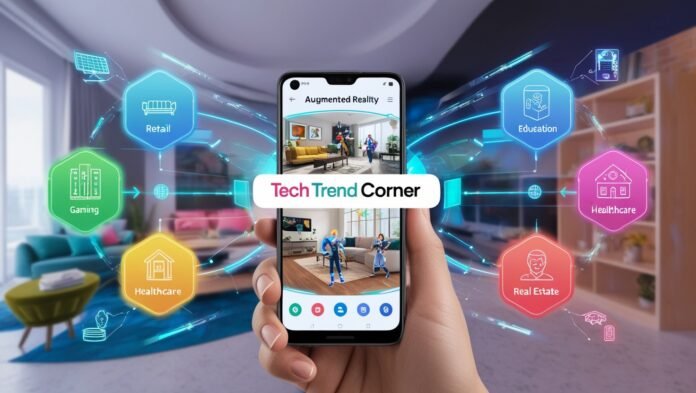Augmented Reality Mobile Apps are changing how we interact with our surroundings. These apps mix digital stuff with the real world, giving us cool and interactive experiences. Whether it’s for games, learning, or shopping, AR mobile apps are making a big difference in many areas.
What Are Augmented Reality Mobile Apps?
Augmented Reality Mobile Apps add digital things to what you see around you. Unlike virtual reality, which creates a whole new world, AR makes the real world better with digital parts. You can see and use both real and virtual things at the same time, making everything look amazing and real.
These apps use your phone’s camera and sensors to understand your environment. They place digital items accurately where you need them. Whether you’re looking at 3D models, finding your way with maps, or trying on clothes virtually, AR mobile apps do a lot of different things to help you.
What Are the Principles Inside AR Mobile Applications?
AR mobile apps have a bright side where hardware and software come together. A camera phone captures the surrounding environment and sends the view. Other sensors, like GPS, alert how you place and rotate your phone using a gyroscope. Smart software then displays digital content in the right place on your screen where you see it.
Vision systems stay essential so apps can recognize surfaces and objects for smooth interaction with the physical world. Developers use tools like ARKit for iPhones and ARCore for Android devices to create effective AR mobile apps. These tools help build apps that are both functional and user-friendly.
How Do AR Mobile Apps Benefit Us?
Many AR mobile apps offer several benefits across different industries. They engage users more by adding interactivity that ordinary apps can’t provide. In education, for example, AR apps make learning fun and help illustrate difficult concepts clearly.
AR mobile apps fit into shopper’s habits and often increase purchases because users can see objects at home before buying them. This reduces uncertainty and makes customers happier with their purchases. In medicine, AR apps greatly impact medical education and patient care by showing detailed 3D models and live updates during treatments.
Furthermore, AR mobile apps boost marketing by creating memorable and easy-to-share experiences. Brands can use this technology to advertise their products in more creative ways, helping attract and keep customers faster.
Usage of AR Mobile Apps in Real Life
Most AR mobile applications receive praise for their fascinating functionalities and user-friendly design. Take the popular mobile game Pokémon GO. It lets players enjoy their character’s alias by looking for and catching monsters in the real world.

IKEA Place also helps users view furniture at home before purchasing. Users can resize furniture using the phone’s camera and see how pieces fit their existing decor, making buying easier.
Another AR application is Snapchat, a picture messaging app that lets users overlay camera images with filters and lenses. Users place virtual elements in real pictures or selfies, making sharing content more entertaining.
Building AR Mobile Applications
Building AR mobile applications requires many stages from conceptualization to launch. The second stage is critical because developers must understand the application’s purpose and target audience. This stage helps create system features that satisfy users.
ARKit and ARCore exemplify the iOS and Android app development platforms, respectively. These tools offer many kits and frameworks, making it easier and quicker to enhance AR features.
Creating engaging interfaces helps operations flow seamlessly. Developers should aim for low learning curves so users engage with the app easily and without lengthy instructions. Testing the application on various devices and settings helps ensure its efficiency.
Future of AR Mobile Apps
The future of Augmented Reality Mobile Apps looks bright, with new technologies making them even better and more common. As phones get more powerful and AR features improve, AR will become a regular part of our daily lives.
5G Technology will greatly enhance AR experiences by providing faster data speeds and lower delays. This will allow for more complex and real-time interactions, making AR apps even more responsive and immersive.
Combining AR with other new technologies like artificial intelligence and the Internet of Things (IoT) will open up even more possibilities. AI can improve how apps recognize and interact with objects, while IoT can connect AR apps with smart devices, creating a smarter and more connected environment.
AR Mobile Apps in Various Industries
Retail and E-commerce
In retail, AR mobile apps enhance the shopping experience by allowing users to view products within their own environment. For instance, applications like IKEA Place and Sephora’s Virtual Artist allow a user to try and see how a piece of furniture would fit into her room and the makeup on her face respectively in order to facilitate the buying process and, with it, the minimization of returns.
Education and Training
With AR mobile apps, learning is more interesting and more effective. Applications such as Google Expeditions are immersive educational tools utilized by learners to transform and build interactively 3D models of historical places, scientific concepts, etc.
Healthcare
Within the healthcare context, augmented reality mobile applications can be used for medical education and to enhance patient care. For example, AccuVein employs augmented reality function to display a picture of the veins beneath the skin surface of the patient, aiding health care personnel find veins suitable for draws or injections.
Entertainment and Gaming
The pioneers of AR mobile apps are within the gaming industry. Titles such as Pokémon GO and Harry Potter: Wizards Unite are augmented reality games that compel players to be more active so that they can experience the external environment with a blend of digital content in it.
Real Estate
Augmented reality mobile applications in real estate allow a prospective client to virtually view the interior of a property. Applications such as Matterport offer 3D tours to remove the need for site visits and enable users to view and choose properties within the shortest time feasible.
Problems Faced in the Process of Creating AR Mobile Apps
Despite AR mobile apps advantages, implementing them poses some difficulties. Ensuring compatibility across devices and platforms challenges developers because AR relies on sensors and cameras.
Developers need high levels of 3D modeling and computer vision knowledge to create AR content quickly. App developers must ensure the application does not hang or overheat, which harms the user experience.
Privacy issues also arise. AR tools often use camera and GPS functionalities, presenting privacy concerns. Developers must implement protective measures and clearly explain how they use such information.
Best Practices for Designing Augmented Reality Mobile Applications
Creating impressive Augmented Reality Mobile Applications means adhering to the accepted principles of design that enhance usability and ultimately satisfaction of the users. Here are important considerations:
- User-Centric Design: Make the interfaces uncomplicated and self-explanatory. Users should be able to use the app with ease after brief instructions and shortly without any guidance. Employ such gestures and interactions that make it easy for the user to assume the experience.
- Optimize Performance: Avoid performance issues like lagging or crashing of the application by ensuring that proper coding is done and the assets are well managed. There should be high performance during execution of the application and smooth running across different configurations for example thanks to optimizing the graphics and minimizing the use of resources.

- Provide Clear Feedback: Provide prompt and sensible feedback for what the users are doing. Whether it is a light blinking of where an object should be placed or a click sound whenever an icon is pressed, feedback influences users on how they interact with the application and enhances their participation.
- Ensure Accurate Tracking: The accurate position and movement tracking of the phone is fundamental for an enjoyable AR experience. Some testing mode should be carried out as well as advanced tracking algorithms incorporated in the application to ensure accurate degree is maintained.
- Prioritize Privacy and Security: Implement safety controls and measures to curb misuse of users’ personal information. Set out the purposes for the use of the users’ data and seek permissions in a transparent manner so as to gain the users’ confidence.
App Development: The AR Mobile Applicator. Tools & Technologies
The success of Augmented Reality Mobile Apps development highly depends on the tools and technologies used acheving this vision. For this purpose, the following are some relevant materials:
Implementing AR in Mobile Apps using ARKit and ARCore
If AR development for mobile devices is to be carried out, then ARKit for iPhones and ARCore for Android phones are the best solutions out there. The supply framework motion and environment understanding and lighting elements make it easy to augment the creation of AR functions with features like motion tracking.
Unity and Unreal Engine
Unreal Engine and Units are widely used game engines that also support AR. They have sophisticated modeling, rendering, and animation tools enabling the creators to provide rich engaging AR content.
Vuforia
Vuforia is a versatile augmented reality toolkit that works on a wide range of devices and boasts functionalities such as image recognition and object tracking. It is compatible with unity which explains why it is one of the most popular tools among mobile phenomenons.
Blender and Autodesk Maya
In as much as 3D artists create spectacular works and animations, applications such as Autodesk Maya and Blender ensure that the finishing of the objects built in unison is flawless. This allows developers to create elaborate and convincing 3D objects which enhances the Augmented reality experience.
3D Scanning Tools
3D scanning tools help in creating a scanned image of an object in the real world and creating a digital version of it. This is important as it helps in coming up with detailed and realistic presentation for the AR mobile applications designed.
Case Studies: Effective AR Mobile Applications
Pokémon GO
Pokémon GO is an exceptional AR-based mobile app quite unlike any other. It connects the users both physically and virtually. Released in 2016, the app made a massive impact as people caught Pokémon in the streets and parks around them. The game requires players to get out of their homes and meet other people which sets a new benchmark in the Augmented Reality games.
IKEA Place
IKEA Place redefines the way we shop for furniture by allowing the user to visualize the object in question in their living space prior to purchasing it. Thanks to AR technology, such customers can assess how well various items incorporate into the design together with the 2D images they already have and avoid guesswork and unnecessary burdens in returning goods.
Google Lens
A tool that enriches the user’s already existing reality in the form of information about objects and text seen through the camera is called Google Lens. From plant identification to barcode scanning, translation of different languages and more, Google Lens offers users a way of assimilating with their environment.
Conceptualizing the Enticement of Users with AR Mobile Apps
To retain the user, Augmented Reality Mobile Apps need to provide value and engender unforgettable instances. Some of the ways are given below:
- Personalization: Personalize the AR experience of the app based on users’ appetites and conduct within the app. Personalized content makes them feel important hence are even more inclined to using the app.
- Interactive Elements: Incorporate interactive features that motivate users to navigate the app. These could include the likes of click able virtual objects, interactive navigational aids as well as confusion games which enhance user appeal.
- Regular Updates: Introduce new components, features, content and advancements regularly, to maintain the wow factor of the app. This informs the users of the constant evolution of the app while providing some novelty in the interface.
- Social Integration: Provide opportunities for users to post their AR experiences on social networks. This is effective because it not only enhances engagement but also serves as marketing by the app through its users.
- Feedback and Support: Wait for users to share their opinions and provide very effective support systems. One resolves their issues and implements their constructive advice to encourage interaction and increase loyalty.
Mobile AR Applications and Their Accessibility
Ensuring that Augmented Reality Mobile Apps available for download are accessible to all users is necessary. Accessibility features enable people with disabilities to use AR apps thus expanding the reach and impact of the app. Here are some things to keep in mind:
- Voice Commands: Include voice commands so that users can use the app even if they have limited mobility. This adds to usability because it is another way of navigating the app other than physical control.
- Text Alternatives: This is useful for users with visual impairments. Give visual elements a text equivalent. This include text captions, and audio descriptions that convey the required content.
- Adjustable Settings: Let users modify the font size, color contrast, or interaction sensitivity to suit them better. Adjustable settings ensure the application caters to different users and their preferences.
- Simplified Interfaces: Create interfaces that are straightforward and easy to use. Kits that contain clear layouts and simple controls enable users with cognitive problems to operate the application without difficulty.
- Haptic Feedback: Incorporate haptic feedback whereby tactile responses are provided for different user actions Non -visual cues enhance the experience and assist users who depend on touch.

Measuring the success of AR Mobile Applications
In order to determine the market performance of Augmented Reality Mobile Applications, it would be appropriate to monitor several key performance indicators (KPIs). Here are some metrics that should be analyzed:
- Interaction of Users with the Application: Assess the extent of users’ interaction with the app, including duration of app usage, app return frequency, and the use of the AR aspects of the app. A high level of engagement indicates that the app is both useful and entertaining to the users.
- Retention Rates: Analyze the portion of users that continue to use the app over given periods of time. High retention rates indicate that the application satisfies the user and is able to sustain their level of interest.
- Conversion Rates: In this instance, it pertains to measuring actions such as purchases, registrations or post content sharing driven by the application. Conversion rates assist in understanding the relationship of the application to the business objectives.
- User Evaluation: Collect and scrutinize the ratings of users in respect of the application to establish the positives and bank on them and the negatives and seek for improvement. High ratings and great reviews indicate that the users are satisfied while constructive criticism provides a way of improving the product.
- Revenue Related Data: Analyze the income earned via various means of income generation within the application such as in-app purchases, advertising, and subscriptions. Revenue related data aids in judging the market performance of an application.
- Technical Characteristics: This includes aspects related to the use of the app, for example, how long it takes to open the app or how often the app crashes or errors occur. Maintaining high technical characteristics is very important for the comfort of users.
Conclusion
Augmented Reality Mobile Applications are transforming the digital sphere by bridging the gap between the virtual and physical worlds. These applications enhance and enrich different aspects of everyday life, such as shopping, education, healthcare, gaming, and entertainment. They offer experiences that are both engaging and enthralling. With advancements in technology on the rise, AR mobile applications have more potential use cases, and developers expect more advanced AR applications.
Launching successful AR mobile applications requires a unique combination of application engagement, creativity, and technical expertise. With the right tools and recommended strategies, developers can create engaging AR content to delight users. As AR technology decreases in cost and spreads across platforms, the number of AR mobile apps will increase greatly. This growth will redefine the way users interact with information on various digital surfaces.
The idea of using Augmented Reality Mobile Apps benefits both businesses and individuals. Users utilize these applications in various ways, such as improving customer service, facilitating learning, or producing interesting content. AR mobile applications are leading the way into this next digital era.
Read more about 5G Technology in 2025: Revolutionary Changes Ahead

